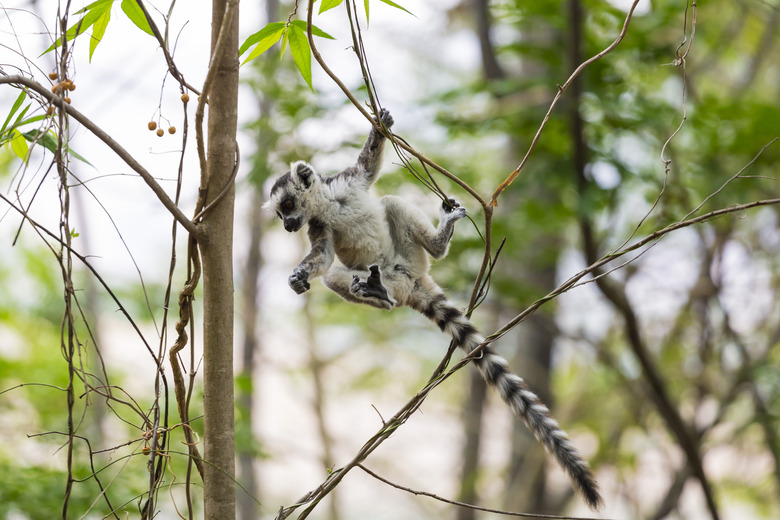Adaptations Of Lemurs
Lemurs are prosimians, one of the more primitive types of primate. They are native only to Madagascar and the nearby Comoro Islands, and life on these remote islands has led to a number of physical adaptations that distinguish lemurs from other primate species. They also have behavioral adaptations that are unusual in primates, such as female social dominance. Lemur species are varied in appearance, ranging from red to black in color. Size also varies, from the size of a mouse to the size of a large cat.
Adaptations for Life in the Trees
Adaptations for Life in the Trees
Although they are well adapted for moving through trees, walking along the ground is more challenging for most lemurs. With the exception of the ring-tailed lemur, all lemurs spend most of their time in trees. Lemurs have one claw on each of their back feet, but most digits have nails. Their hands allow these animals to grab branches for climbing and feeding. Young lemurs also use this grip to hold onto their mother's fur. Another useful lemur adaptation is their strong back legs that allow them to jump between trees. Long tails help them to keep their balance.
Nocturnal Lemurs
Nocturnal Lemurs
Most species of lemur are nocturnal. This helps protect them from predators. "Lemur" translates as "ghost" in Latin. The animal earned this name from its habit of appearing in trees at night. Eyesight is not the lemur's strongest sense, but its developed sense of smell, aided by a long, wet nose, is useful at night.
Social Behavior
These animals often form social groups, or troops, of between two and five lemurs, although larger groups are formed occasionally. These troops provide protection from predators through safety in numbers. When danger is present, lemurs alert other members of their troop through vocalized warnings. Some species, such as ring-tailed lemurs, use the also use their distinctive tails to communicate send signals to other members of their troops.
Grooming
Grooming
Lemurs such as the black and white ruffed lemur reinforce social bonds through an unusual method of grooming one another. As their fingers are not dexterous to be able to groom fur effectively with their hands, lemurs have developed lower teeth that stick out and can groom fur in a similar way to a comb. After grooming, a pointed nodule on the underside of the lemur's tongue is used to clean debris from these teeth.
Stink Fights
Stink Fights
During the lemur mating season, males compete for mates through behavior known as a stink fight. Male lemurs have scent glands on their wrists. During a stink fight, males smear secretions from their scent glands along the length of their tail. The lemur with the strongest scent wins the female. Outside of a stink fight, lemurs also use these scent glands to mark territory and communicate with each other.
Cite This Article
MLA
Ames, Hayley. "Adaptations Of Lemurs" sciencing.com, https://www.sciencing.com/adaptations-lemurs-8484264/. 24 April 2018.
APA
Ames, Hayley. (2018, April 24). Adaptations Of Lemurs. sciencing.com. Retrieved from https://www.sciencing.com/adaptations-lemurs-8484264/
Chicago
Ames, Hayley. Adaptations Of Lemurs last modified March 24, 2022. https://www.sciencing.com/adaptations-lemurs-8484264/
